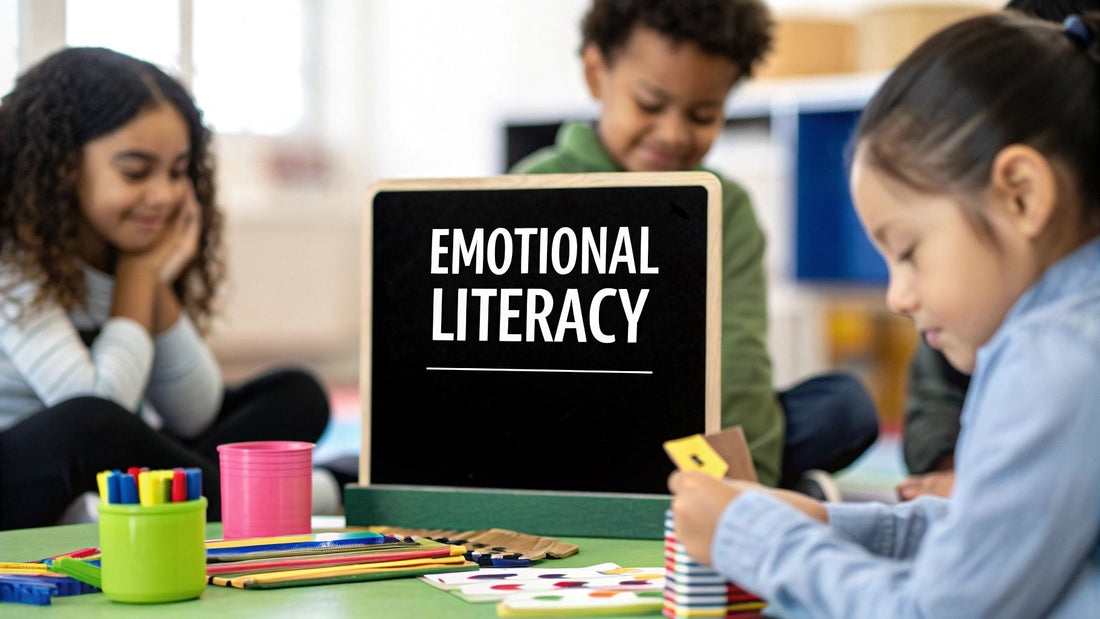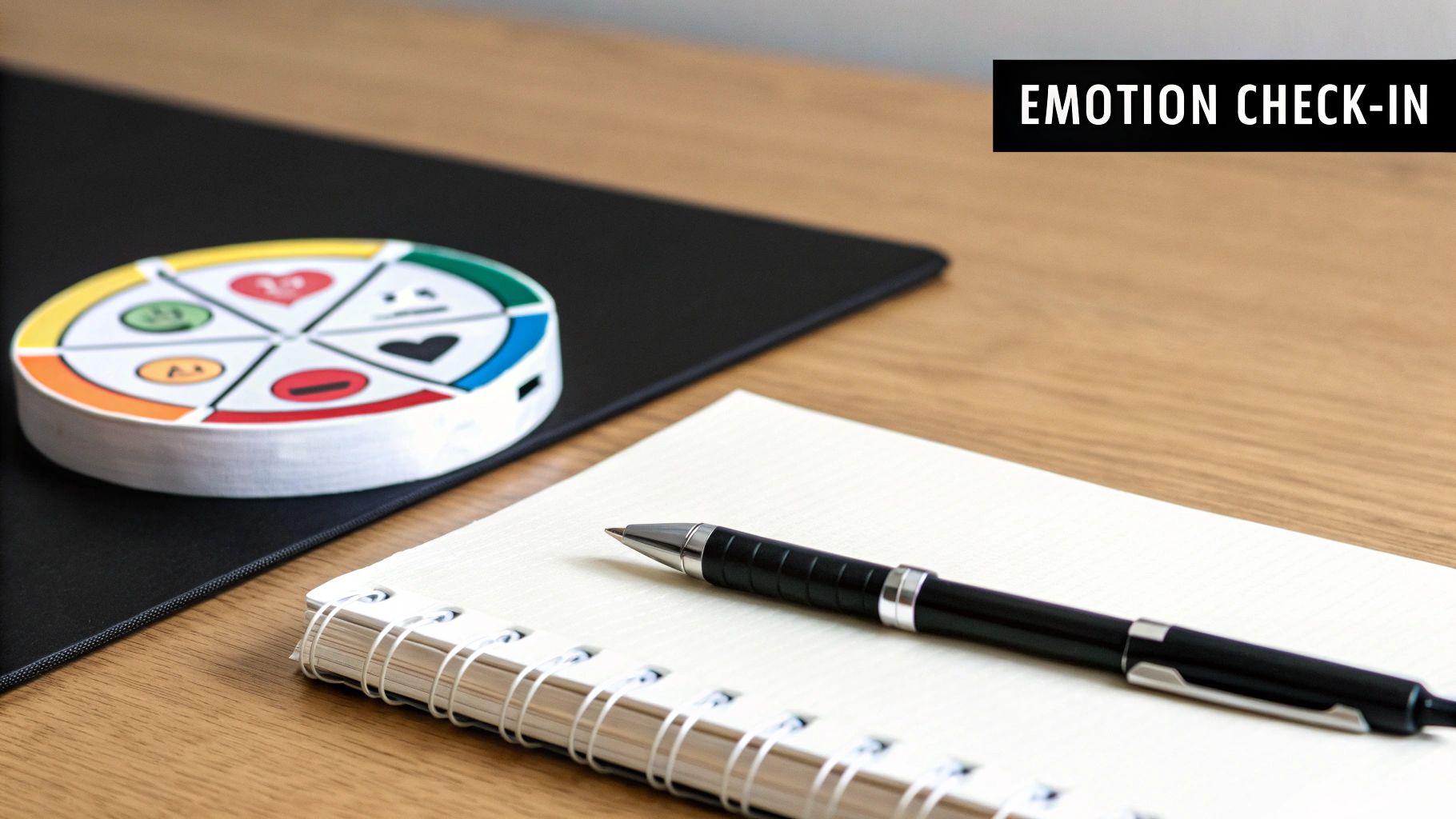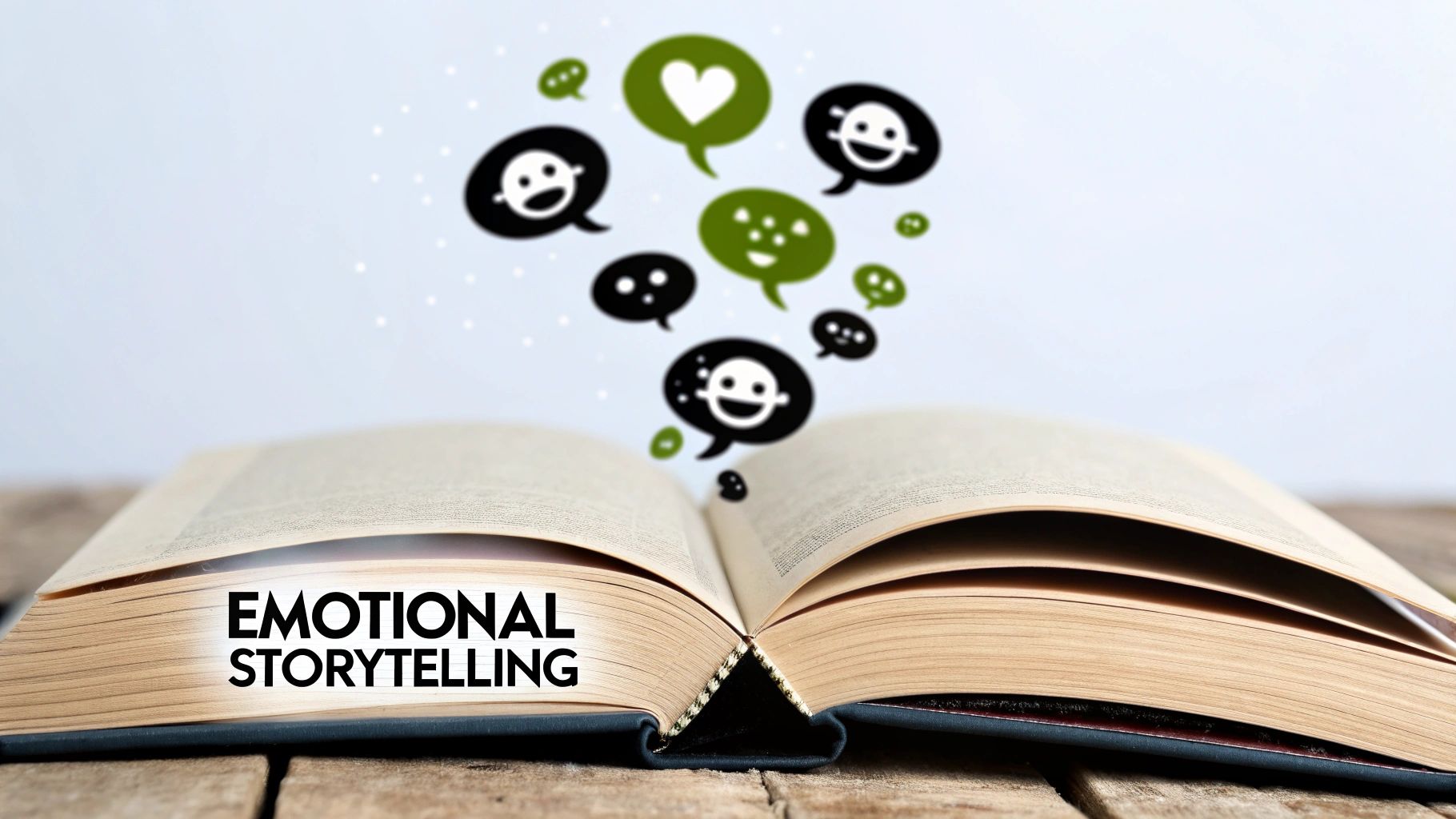
Top Emotional Literacy Activities for Kids in 2025
Share
In an era where children's mental health is a growing concern in the UK, equipping them with the tools to understand and manage their feelings is more crucial than ever. Recent statistics highlight that 1 in 6 children aged 7 to 16 has a probable mental health problem, a situation often intensified by the pressures of social media. This isn't just a personal issue; poor mental health costs UK employers up to £56 billion a year, underscoring the long-term value of early intervention.
This guide offers seven practical, powerful emotional literacy activities designed to build resilience, empathy, and wellbeing from a young age. These are not just games; they are foundational skills for life, helping children navigate the complexities of their inner worlds with confidence. Each activity provides a structured way to explore feelings, develop coping mechanisms, and strengthen communication. For those seeking further structured development in this area, exploring emotional intelligence coaching for teens can be incredibly beneficial.
From simple check-ins to creative expression, you will find actionable strategies to support the young people in your life. Please remember, while these activities are beneficial, I am not a mental health professional. If you have serious concerns about a child's mental wellbeing, it is essential to consult a GP or a qualified professional for guidance.
1. Emotion Check-ins
Emotion Check-ins are a foundational practice in developing self-awareness and are among the most effective emotional literacy activities for all ages. This structured routine involves regularly pausing to identify and articulate one's current emotional state. By creating a dedicated time to reflect, individuals learn to connect with their inner world, building a crucial bridge between feeling an emotion and understanding it. The goal is to normalise conversations about feelings, turning an abstract internal experience into a tangible concept that can be discussed and managed.

This practice is highly adaptable, making it suitable for diverse settings. In a primary school classroom, a teacher might start the day by having children point to a feeling on a colourful "Emotion Wheel." A practical example would be for a family to start dinner by each sharing a "rose" (a good thing from the day) and a "thorn" (a challenging thing). The simplicity of the check-in belies its power; it consistently reinforces the idea that all emotions are valid and worthy of acknowledgement.
Why It's a Vital Skill
Creating a routine for emotional expression is more important than ever. With rising concerns about youth mental health, particularly the impact of social media, providing children with tools to understand their feelings is essential. An Emotion Check-in is a proactive strategy that builds resilience from a young age, helping children navigate the complex emotional landscapes of modern life. It's a vital step in addressing mental health early.
How to Implement Emotion Check-ins
Getting started is simple. The key is consistency and creating a safe, non-judgemental space.
- Choose Your Tool: For younger children, visual aids like feeling thermometers or charts with expressive faces work well. Teenagers and adults might prefer a simple verbal check-in or using a journal.
- Model Vulnerability: Lead by example. Begin by sharing your own feelings honestly. Saying, "I'm feeling a bit tired and anxious today," shows others that it's okay not to be okay.
- Start Simple: Begin with basic emotions like happy, sad, angry, and scared. As emotional vocabulary grows, you can introduce more nuanced feelings like frustrated, content, or apprehensive.
- Connect to the Body: Encourage children to notice where they feel an emotion. Ask questions like, "Where do you feel that anger in your body? Is it a tightness in your tummy or heat in your face?" This builds a deeper mind-body connection.
This activity establishes a powerful habit of self-reflection. By regularly pausing to ask "How am I feeling?", we equip ourselves and our children with the first and most critical step towards emotional regulation and well-being.
2. Emotional Storytelling and Narrative
Emotional Storytelling and Narrative is a powerful activity that leverages the innate human connection to stories to build emotional understanding. This approach uses books, films, or personal accounts to explore complex feelings in a safe, relatable context. Participants analyse characters' emotions, motivations, and journeys, connecting these fictional experiences to their own lives, which makes this one of the most effective emotional literacy activities for developing empathy. The goal is to use the emotional distance of a story to open up conversations about real feelings.

This method is incredibly versatile. For young children, a teacher might read a picture book like The Colour Monster and discuss why a character feels sad or excited. For older children, a film like Pixar's Inside Out provides a fantastic visual framework for discussing core emotions and memory. In a therapeutic setting, a counsellor might use narrative therapy to help a teenager reframe their own life story. The story acts as a mirror, allowing individuals to see their own feelings reflected in a less intimidating way.
Why It's a Vital Skill
Stories provide a crucial "scaffolding" for emotional conversations. In a world where direct emotional expression can feel daunting, especially with the pressures of social media, narratives offer a common language. Discussing a character's struggles with anxiety or frustration gives children and adults the vocabulary and confidence to talk about their own. It builds a foundation for teaching emotional awareness to children, which is essential for developing healthy relationships and resilience.
How to Implement Emotional Storytelling
The key is to move beyond simply consuming the story and actively engage with its emotional content.
- Choose Diverse Narratives: Select stories that feature a wide range of emotional experiences and characters from various backgrounds. Mental health books, like those exploring anxiety or friendship, can be excellent tools.
- Ask Open-Ended Questions: Go beyond "How did the character feel?" Ask questions like, "Why do you think they reacted that way?" or "Have you ever felt a bit like that character? What happened?"
- Map the Emotional Journey: Use a simple timeline or story map to trace a character's feelings from the beginning of the story to the end. This visually demonstrates how emotions can change over time and in response to events.
- Encourage Personal Connections: Create a safe space for participants to share their own related experiences if they feel comfortable. Start by modelling this yourself, saying something like, "That part reminds me of a time I felt really nervous."
This activity transforms passive entertainment into an active tool for emotional growth. By exploring feelings through the lives of others, we learn to better understand and articulate our own complex inner worlds.
3. Role-Playing and Drama Therapy
Role-Playing and Drama Therapy is an interactive and dynamic approach to building emotional literacy. It utilises theatrical techniques and improvisation to allow individuals to explore complex feelings and practise emotional responses in a controlled, safe environment. By stepping into another person's shoes or acting out a challenging scenario, participants can experiment with different ways of expressing themselves and reacting to others, turning abstract emotional concepts into tangible, lived experiences.

Pioneered by figures like Jacob Moreno, this method is highly effective because it moves beyond mere discussion. In an anti-bullying programme, a child might role-play how to ask for help from a teacher after being teased. Similarly, a teenager could practise telling a friend they are worried about their social media use. This active participation helps to hardwire more constructive emotional habits.
Why It's a Vital Skill
Empathy and perspective-taking are cornerstones of healthy relationships and social competence. In a world where digital interactions can sometimes lack nuance and compassion, practising these skills is crucial. For young people, these activities offer a rehearsal for real-life challenges, from resolving playground conflicts to navigating peer pressure. It provides a space to fail safely, learn from mistakes, and build confidence in their ability to handle emotionally demanding situations.
How to Implement Role-Playing
Creating a supportive atmosphere is paramount to the success of these emotional literacy activities. Trust and clear boundaries enable participants to be vulnerable and experiment freely.
- Establish Clear Ground Rules: Before starting, create safety agreements. Key rules should include "no judgement," "what's shared here stays here," and giving everyone the right to pass or "opt out" without penalty.
- Start with Low-Stakes Scenarios: Begin with simple, less emotionally intense situations. For instance, role-play asking a friend to share a toy before moving on to more complex topics like managing disappointment or resolving a serious argument.
- Use Props and Costumes: Simple props like hats or scarves can help participants, especially younger children, feel less self-conscious and more easily step into character. This creates a psychological distance that encourages freer expression.
- Facilitate a De-brief: After each role-play, dedicate time to discussion. Ask guiding questions like, "How did it feel to be in that role?" and "What would you do differently next time?" This reflection is where the most significant learning occurs.
4. Mindfulness and Body Awareness Exercises
Mindfulness and Body Awareness Exercises are powerful emotional literacy activities designed to connect the mind and body. These structured practices help individuals recognise the physical sensations associated with different emotions, fostering present-moment awareness. The core principle is that emotions are not just abstract feelings; they manifest physically within us. By learning to notice how anxiety tightens the chest or how excitement creates a fluttery feeling in the stomach, we build a foundation for somatic experiencing and effective emotional regulation.

This approach is incredibly versatile. It can be as simple as a primary school teacher guiding children through 'belly breathing' exercises before a challenging lesson, or as structured as a corporate stress management programme using body scan techniques to help employees manage workplace pressure. This practice teaches a crucial skill: to observe our internal state without immediate reaction, creating a vital pause between feeling an emotion and acting on it.
Why It's a Vital Skill
In an era where children are constantly stimulated by digital devices and social media, the ability to turn inward and listen to one's body is more critical than ever. Teaching mindfulness grounds children in their physical reality, providing an anchor in the often-turbulent sea of emotions. This practice is a proactive strategy to build resilience, helping children and adults alike to better manage stress and anxiety by understanding their physiological warning signs.
How to Implement Mindfulness and Body Awareness Exercises
Introducing these practices should be a gentle and gradual process. The goal is observation, not perfection.
- Start Small: Begin with very short sessions, just 2-3 minutes long, especially with younger children. You can gradually increase the duration as they become more comfortable with the practice.
- Use Guided Resources: For beginners, guided audio or visual cues are incredibly helpful. Resources like children's guided meditations can provide a structured and engaging starting point.
- Connect Sensations to Feelings: Actively help children make the connection. Ask, "When you felt frustrated, what did you notice in your hands? Were they tight fists?" This builds their somatic vocabulary.
- Practise When Calm: Introduce these exercises during calm, peaceful moments first. This builds the skill in a low-stakes environment, making it easier to access during times of heightened stress or emotional distress. One practical relaxation tip is the '5-4-3-2-1' technique: name 5 things you can see, 4 things you can feel, 3 things you can hear, 2 things you can smell, and 1 thing you can taste.
By integrating these exercises into a routine, you equip individuals with a profound tool for self-awareness, creating a stronger mind-body connection that is fundamental to lifelong emotional well-being.
5. Art and Creative Expression Therapy
Art and Creative Expression Therapy provides a powerful, non-verbal pathway to explore feelings, making it one of the most inclusive emotional literacy activities available. This approach uses mediums like drawing, painting, collage, or sculpture to help individuals process emotions that may be too complex or overwhelming to articulate with words. It allows for a symbolic representation of one’s inner world, bypassing the cognitive filters that can sometimes hinder verbal expression.
This method is incredibly versatile. A practical example would be creating a 'worry box' where a child can draw or write down their anxieties and physically place them inside the box to 'contain' them. In a primary school, children could be asked to draw "feeling faces" to express how their day is going. The beauty of art therapy is that it focuses on the process of creation rather than the final product, creating a safe space for authentic expression without the fear of judgement.
Why It's a Vital Skill
For many children and young people, especially those who find verbal communication challenging, art offers a vital alternative outlet. In a world where mental health concerns are growing, providing non-verbal tools for expression is crucial. This approach allows individuals to externalise internal struggles, making them tangible and easier to understand, which is a foundational step toward developing coping mechanisms and emotional resilience.
How to Implement Art and Creative Expression
Creating a supportive environment is the key to unlocking the benefits of art as a tool for emotional literacy.
- Emphasise Process Over Product: Reassure participants that there is no "right" or "wrong" way to create. The goal is to express feelings, not to produce a masterpiece.
- Provide Diverse Materials: Offer a range of materials like crayons, paint, clay, and collage supplies. Different textures and colours can evoke different emotional responses. For practical ideas, you might find inspiration in these creative art projects for preschoolers.
- Use Gentle Prompts: Start with simple prompts like, "Draw what anger looks like," or "Use colours to show how you're feeling today." This provides a starting point without being overly prescriptive.
- Facilitate Reflection: After the creative process, allow time for reflection. Ask open-ended questions like, "Can you tell me about what you've made?" but avoid interpreting their work for them. This empowers them to find their own meaning.
By integrating art into emotional learning, we give children a versatile language to communicate their inner experiences, fostering a deeper sense of self-understanding and emotional well-being.
6. Emotion Regulation Skill-Building
Emotion Regulation Skill-Building moves beyond merely identifying feelings to systematically teaching and practising specific techniques for managing emotional responses. This structured approach provides a toolkit of strategies to navigate intense emotions effectively. It encompasses cognitive techniques like reframing negative thoughts, behavioural skills such as deep breathing, and interpersonal abilities like setting boundaries, all designed to build resilience and emotional wellness.
This method is highly practical and can be adapted across various contexts. In schools, it might form part of a Social and Emotional Learning (SEL) curriculum, teaching children grounding techniques to manage anxiety before an exam. A practical example is creating a 'calm-down corner' in the home with soft cushions, a weighted blanket, and fidget toys, where a child can go to practise their breathing techniques when they feel overwhelmed. The core principle is that emotional regulation is not an innate talent but a set of skills that can be learned, practised, and mastered over time.
Why It's a Vital Skill
Teaching explicit regulation skills is crucial in a world where children face significant pressures from social media and academic expectations. With rising rates of anxiety and depression among young people, providing them with a concrete toolkit is a proactive mental health strategy. These skills empower them to feel in control of their reactions rather than being overwhelmed by them, fostering a sense of competence and self-efficacy.
How to Implement Emotion Regulation Skill-Building
A methodical approach ensures these skills become reliable habits. The key is to practise during calm moments so they are accessible during times of stress.
- Start with Core Techniques: Introduce one or two foundational skills first, such as "box breathing" (inhaling for four counts, holding for four, exhaling for four, holding for four) or progressive muscle relaxation.
- Practise When Calm: Rehearse these techniques when your child is relaxed and receptive. This builds the muscle memory needed to use the skill automatically when feeling upset or anxious.
- Create Visual Reminders: Use cue cards or posters that illustrate the steps of a specific skill, like a "5-4-3-2-1" grounding exercise. Place them in a visible spot like a bedroom or a calming corner.
- Connect Feelings to Strategies: Help children link specific emotions to helpful skills. You could say, "It looks like you're feeling frustrated. Do you remember our deep breathing exercise? Let’s try it."
This focus on actionable strategies makes emotional literacy tangible and empowers individuals with the tools they need to manage stress effectively. To build on this, explore more ways to manage stress on thatsokay.co.uk and find techniques that work best for your family.
7. Emotional Journaling and Reflection
Emotional Journaling and Reflection is a powerful introspective practice that helps individuals process their inner world through writing. This structured activity involves regularly recording feelings, identifying triggers, and exploring responses, creating a tangible record of one's emotional landscape. By translating abstract feelings into written words, individuals can analyse patterns, process difficult experiences, and develop more considered emotional responses, making it one of the most effective emotional literacy activities.
This method is highly personal and adaptable. A young child might draw their feelings and have a parent write down a simple description, while a teenager could use a mood tracking app with a notes section to log daily emotions. A practical example is a 'three good things' journal, where a child writes down three positive things that happened each day before bed, which helps to reframe their focus and cultivate gratitude. The core principle is consistent: providing a private, non-judgemental space to explore emotions without fear of criticism.
Why It's a Vital Skill
In the UK, staggering statistics show that 1 in 6 children aged 5 to 16 are likely to have a mental health problem. Journaling offers a private outlet to process the daily pressures from school, social media, and peer relationships. It teaches young people to become observers of their own minds, fostering self-compassion and empowering them to articulate their needs more clearly, a crucial skill for seeking support when needed.
How to Implement Emotional Journaling
The key is to make journaling an accessible and unpressured routine. Consistency is more important than length or perfection.
- Use Guiding Prompts: For beginners, an empty page can be intimidating. Use prompts like, "Today I felt proud when…," "A moment that made me feel frustrated was…," or "What did my body feel like when I was anxious?"
- Set Realistic Goals: Start with just five minutes a few times a week. The goal is to build a sustainable habit, not to write a novel. A gratitude journal focusing only on positive emotions can be a gentle starting point.
- Focus on Feelings, Not Just Events: Encourage a shift from detailing what happened to exploring how it felt. Ask, "How did that situation make you feel?" and "What was your first reaction?"
- Review and Reflect: Periodically read back through past entries. This is where the real learning happens, as it helps to identify recurring emotional patterns, triggers, and personal growth over time.
This reflective practice builds a profound level of self-awareness, helping individuals connect the dots between their experiences and their emotional reactions, paving the way for greater emotional regulation.
Emotional Literacy Activities Comparison Table
| Approach | Implementation Complexity 🔄 | Resource Requirements ⚡ | Expected Outcomes 📊 | Ideal Use Cases 💡 | Key Advantages ⭐ |
|---|---|---|---|---|---|
| Emotion Check-ins | Low – simple routine, minimal steps | Minimal – mostly visual aids | Increased emotional vocabulary & self-awareness | Daily routines, classrooms, teams, families | Easy to implement, quick, builds awareness |
| Emotional Storytelling and Narrative | Medium – needs content selection and facilitation | Moderate – media/books needed | Enhanced empathy, emotional understanding | Education, therapy, corporate training | Engages multiple learning styles, relatable |
| Role-Playing and Drama Therapy | High – requires skilled facilitation and safe environment | High – space, props, time | Improved emotional expression, empathy, confidence | Therapy, schools, workplace communication | Embodied learning, safe practice for emotions |
| Mindfulness and Body Awareness Exercises | Medium – consistent practice required | Minimal – no equipment necessary | Better emotional regulation and self-awareness | Stress management, therapy, schools, sports psychology | Concrete body anchors, practical self-regulation |
| Art and Creative Expression Therapy | Medium – materials and facilitation needed | Moderate – arts supplies required | Non-verbal emotional expression and deeper insight | Therapy, schools, community programmes | Bypasses verbal barriers, creative engagement |
| Emotion Regulation Skill-Building | High – structured teaching & practice | Moderate – trained facilitators | Practical tools for managing emotions long-term | Therapy, schools, workplace wellness, parenting | Research-backed, actionable, confidence building |
| Emotional Journaling and Reflection | Low-Medium – requires discipline & structure | Minimal – pen/paper or digital | Increased emotional insight and pattern awareness | Individual reflection, therapeutic use, wellness programmes | Private, accessible, tracks emotional growth |
Your Next Steps in Nurturing Emotional Wellbeing
Integrating the diverse range of emotional literacy activities discussed in this guide is a powerful step towards building a future where young people feel seen, heard, and understood. From the daily simplicity of 'Emotion Check-ins' to the creative depth of Art Therapy and the reflective practice of Emotional Journaling, each activity serves as a vital tool. These aren't just one-off exercises; they are building blocks for a lifetime of emotional resilience and self-awareness.
The journey begins with consistency. The key takeaway is not to implement every strategy at once, but to choose one or two that resonate with your child or students and weave them into your regular routines. By creating a predictable and safe space for exploring feelings, you normalise the conversation around mental health, making it as natural as discussing physical health. This proactive approach is crucial, especially when considering the significant impact of social media and academic pressures on today's youth.
Making Emotional Literacy a Daily Practice
To truly embed these concepts, consider the following actionable steps:
- Start Small: Dedicate five minutes each day to an 'Emotion Check-in' at the dinner table or before bed. This simple ritual can open the door to deeper conversations.
- Model the Behaviour: As a parent, caregiver, or educator, openly share your own feelings in an age-appropriate way. Wearing mental health apparel with positive affirmations can be a subtle yet powerful way to signal that emotions are a normal part of life.
- Create a Calm Environment: Before starting an activity, use simple relaxation tips like taking three deep, slow breaths together. This helps to centre everyone and prepares their minds for a more focused and calm interaction.
Remember, the goal is progress, not perfection. There will be days when a child is not receptive, and that's okay. The value lies in persistently offering the opportunity and demonstrating that their emotional world matters. The long-term benefits are immense, contributing not only to individual wellbeing but also to creating more empathetic and compassionate communities. A young person equipped with emotional literacy is better prepared for challenges, builds stronger relationships, and develops a healthier sense of self.
Important Disclaimer: The information and activities provided in this article are for educational purposes only. I am not a mental health professional. If you have serious concerns about a child's mental health or your own, it is essential to seek guidance from a qualified GP, counsellor, or medical professional who can provide a proper diagnosis and tailored support.
Building a foundation of emotional intelligence is one of the most significant gifts you can give a child. It empowers them to navigate life's complexities with confidence and grace, fostering a future where mental health is prioritised and protected.
Ready to take the next step? Explore the curated collection of mental health books and resources at Little Fish Books. Our beautifully illustrated stories and accompanying free colouring sheets are specifically designed to complement these emotional literacy activities, making complex feelings accessible and understandable for young minds. Visit Little Fish Books to discover tools that can help you continue these vital conversations.
